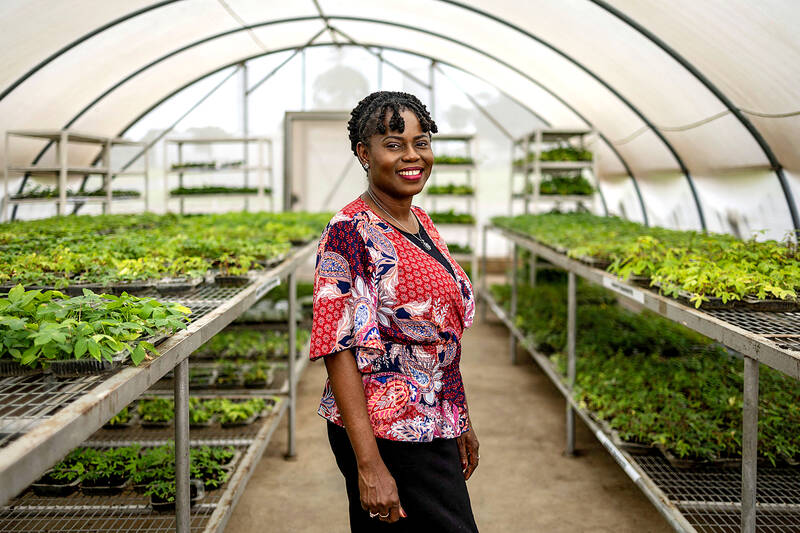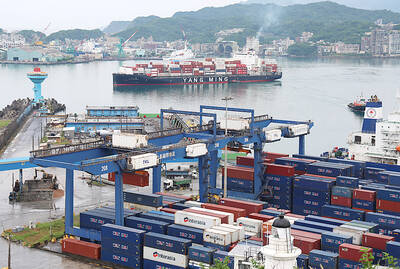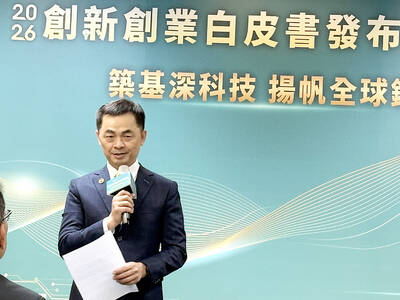Mercy Diebiru-Ojo’s ambitions are straightforward — increase Nigerian yam and cassava yields by 500 percent, fight hunger and raise her country’s position on the agricultural value chain from a mere grower to a processor.
The first steps, at least, are already under way for the 44-year-old agronomist, who was awarded this year’s prestigious Africa Food Prize for her research on yams and cassava, both major food staples in Africa.
Traditionally, farmers in Nigeria — which produces 70 percent of the world’s yams — replant chunks of yams and cassava from the previous year’s harvest, to grow this year’s crop.

Photo: AFP
Gradually, the plants lose their resistance to diseases — a serious problem for food security in a country where 30 million people are not getting enough to eat, according to the UN World Food Programme.
Diebiru-Ojo’s research involves growing the plants hydroponically in greenhouses, where they are protected from disease.
Then, as they sprout, a portion is cut and planted in potted mineral-rich soil in the greenhouse.
Only later is it replanted in the fields outside.
“So your materials are going to grow very vigorously in terms of vegetative growth, even the root formation and all of that,” Diebiru-Ojo said in an interview on the sprawling campus of the International Institute of Tropical Agriculture (IITA), in the southwestern city of Ibadan.
The result — 30 tonnes of yams and cassava per hectare, compared with the typical five.
HUGE POTENTIAL
Diebiru-Ojo worked with US agro-research firm Sahtechno, which developed what it calls “semi-autotrophic hydroponics” (SAH) about two decades ago, to adapt the technique to Nigerian agriculture.
Her techniques, if widely adopted, could be welcome news for the country’s farmers.
Despite being the world’s top cassava producer, “when it comes to the yield, actual yield potentials and all of that, we are still way behind,” Diebiru-Ojo said.
As is the case in many African countries, skilled farmers, with generations of knowledge, face a host of challenges.
They must rely on seasonal rains for irrigation, soils are declining in health, financing costs are high, and governments have limited budgets for extension services.
Despite producing about 20 percent of the world’s cassava each year, Africa’s most populous country still imports about US$600 million in cassava products, Central Bank of Nigeria data showed.
Yams are also a prized ingredient in Nigerian cuisine — fried, boiled, mashed or turned into flour.
However, there is also a huge — if largely unrealized — potential for their use in bioplastics and biofuels, as well as cosmetics, pharmaceuticals and textiles, due to their starch.
Moving up the so-called “value chain” — switching from producing raw materials to transforming them into finished products — is a key step in any country’s economic development, economists say.
Diebiru-Ojo, who was named an Africa Food Prize laureate last month alongside Kenya’s Mary Abukutsa-Onyango, is quick to talk of a “revolution of the cassava sector” in Nigeria.
It is an ambition shared by the government — at least rhetorically — in a country where critics say a focus on oil has long sidelined investments in agriculture.
‘STRATEGIC ASSET’
“Cassava is one of the most strategic assets in our agricultural portfolio,” Nigerian Vice President Kashim Shettima said in July.
He specifically mentioned the IITA’s research and the need to do more processing and food transformation locally.
The promise of increased yields also comes at a time when rural farms are under pressure from various armed groups — jihadists in the northeast, armed gangs in the northwest and farmer-herder conflicts in the Middle Belt.
The country’s myriad conflicts are adding to existing pressures on hunger and food inflation, but with better techniques, even in “a very small space, maybe just a garden behind your house, you can produce a lot,” Diebiru-Ojo said.
Take-off would require help from the private sector to market the seeds and train farmers on SAH. Already, the IITA collaborates with public institutions and private companies in 15 countries on the continent.
The objective is “helping a food-secure Africa, not only Nigeria,” Diebiru-Ojo said.
A bonus would be for her win to serve as an “inspiration to a whole lot of others coming, especially for the women in agriculture,” she added.

CHIP RACE: Three years of overbroad export controls drove foreign competitors to pursue their own AI chips, and ‘cost US taxpayers billions of dollars,’ Nvidia said China has figured out the US strategy for allowing it to buy Nvidia Corp’s H200s and is rejecting the artificial intelligence (AI) chip in favor of domestically developed semiconductors, White House AI adviser David Sacks said, citing news reports. US President Donald Trump on Monday said that he would allow shipments of Nvidia’s H200 chips to China, part of an administration effort backed by Sacks to challenge Chinese tech champions such as Huawei Technologies Co (華為) by bringing US competition to their home market. On Friday, Sacks signaled that he was uncertain about whether that approach would work. “They’re rejecting our chips,” Sacks

Taiwan’s exports soared 56 percent year-on-year to an all-time high of US$64.05 billion last month, propelled by surging global demand for artificial intelligence (AI), high-performance computing and cloud service infrastructure, the Ministry of Finance said yesterday. Department of Statistics Director-General Beatrice Tsai (蔡美娜) called the figure an unexpected upside surprise, citing a wave of technology orders from overseas customers alongside the usual year-end shopping season for technology products. Growth is likely to remain strong this month, she said, projecting a 40 percent to 45 percent expansion on an annual basis. The outperformance could prompt the Directorate-General of Budget, Accounting and

NATIONAL SECURITY: Intel’s testing of ACM tools despite US government control ‘highlights egregious gaps in US technology protection policies,’ a former official said Chipmaker Intel Corp has tested chipmaking tools this year from a toolmaker with deep roots in China and two overseas units that were targeted by US sanctions, according to two sources with direct knowledge of the matter. Intel, which fended off calls for its CEO’s resignation from US President Donald Trump in August over his alleged ties to China, got the tools from ACM Research Inc, a Fremont, California-based producer of chipmaking equipment. Two of ACM’s units, based in Shanghai and South Korea, were among a number of firms barred last year from receiving US technology over claims they have

BARRIERS: Gudeng’s chairman said it was unlikely that the US could replicate Taiwan’s science parks in Arizona, given its strict immigration policies and cultural differences Gudeng Precision Industrial Co (家登), which supplies wafer pods to the world’s major semiconductor firms, yesterday said it is in no rush to set up production in the US due to high costs. The company supplies its customers through a warehouse in Arizona jointly operated by TSS Holdings Ltd (德鑫控股), a joint holding of Gudeng and 17 Taiwanese firms in the semiconductor supply chain, including specialty plastic compounds producer Nytex Composites Co (耐特) and automated material handling system supplier Symtek Automation Asia Co (迅得). While the company has long been exploring the feasibility of setting up production in the US to address